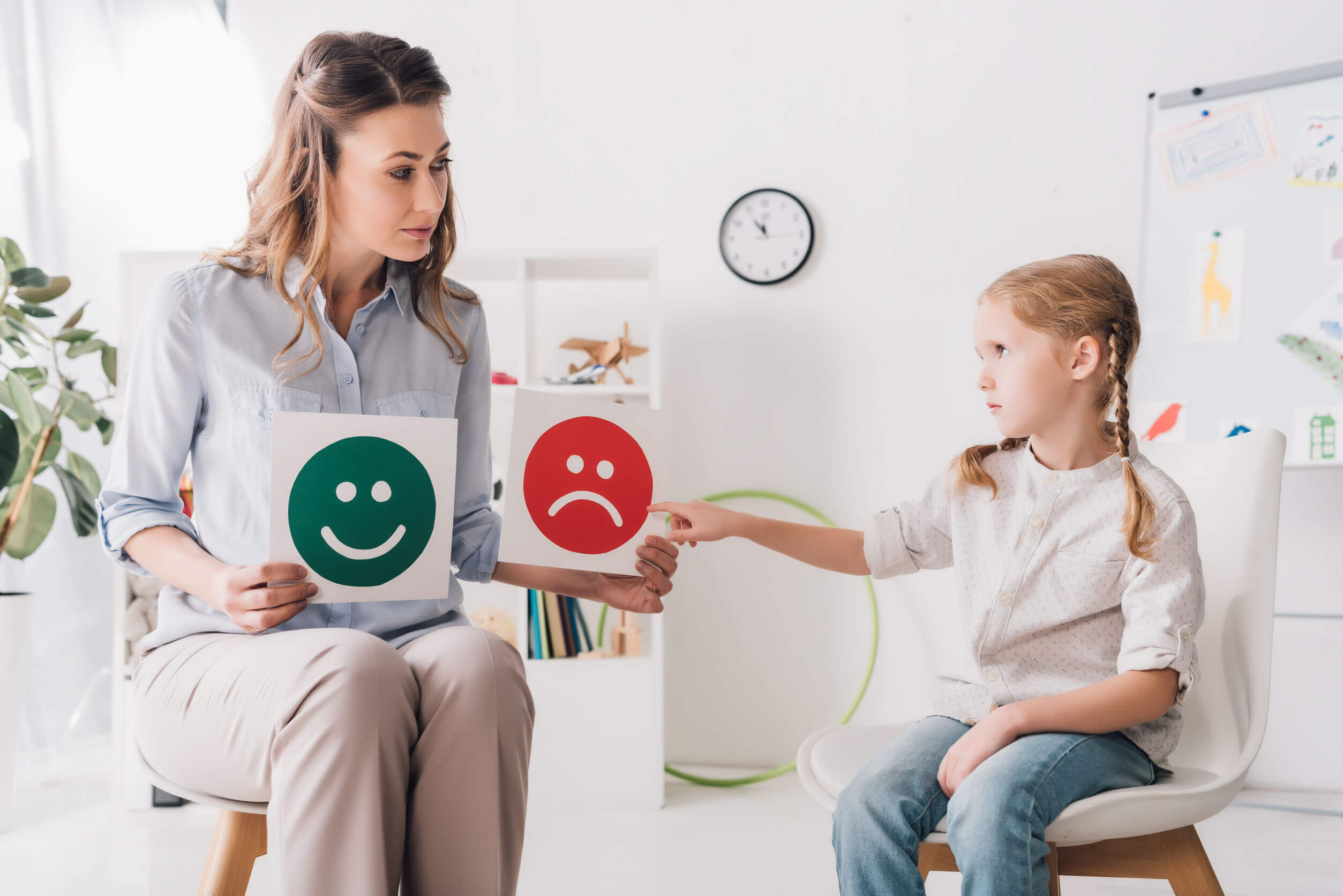How Can We Help Our Children Fight Sadness?


Written and verified by the psychologist Mara Amor López
Sadness is an emotion just like anger, fear, or joy. All feelings serve the function of providing emotional balance to a person. However, emotions, even negative ones, if we know how to manage them, help us to overcome problems. Children, like adults, can also feel distressed. But how can parents help their children fight sadness? We’ll tell you in this article.
In times of pessimism or difficulties, sadness can motivate us to ask for help and give us the push we need to overcome that “bump”. The thing is that this, in the society we live in, isn’t well seen, and we all try to repress it. No one wants to be seen as sad because it makes them look weak or vulnerable. For this reason, it’s important to educate children not to repress sadness, but to fight it.
Playing down children’s sadness doesn’t help
There are different circumstances that can make children feel sad: A prolonged absence of their parents, a move, changing schools, the death of a pet, the death of a family member, among others. No parent likes to see their children sad or go through these situations, so everyone tries to prevent them from feeling that way. When we don’t succeed, we try to minimize the importance of what has happened, but this isn’t the best option.

Fighting sadness in children: When should we worry?
Sadness is an emotion like any other, it’s neither good nor bad, and it always has a function. There are many situations that can make children feel sad. What happens is that these are temporary states that children feel momentarily and we shouldn’t worry beyond the fact that it’s something circumstantial. The problem is when sadness starts to become part of the child’s life more than it should, and then, yes, we must intervene. Here are some examples:
- The child cries very frequently and for any reason.
- The sadness that your child feels is prolonged over time.
- The child doesn’t want to eat and doesn’t seem hungry or, on the contrary, eats excessively.
- Problems falling asleep, they move around a lot in bed at night without getting as much sleep as they should.
- They get angry and complain when something doesn’t go well.
- They’ve lost all interest in playing with other children and even alone.
- Behavioral problems appear.
- They start to speak very little, when they’ve always been communicative.
Tips to help our children fight sadness
It’s important for parents to help their children understand the emotions they feel, in this case, sadness. They should be able to recognize the different moods and know how to express them with words. To do this, we must take into account these points:
Parents shouldn’t hide their own sadness when they feel it
We all know that children learn from the example of their parents, and if they hide their feelings and emotions from their children, their children will do the same. Therefore, it’s important for adults to explain to children why we feel sad so that they have examples of similar situations when they feel that way.
Help children identify what they feel
Sometimes children are confused about what they feel and express it through aggressive behavior, such as hitting or pushing. Sadness is an emotion that can be accompanied by frustration and anger. Parents should help their children to identify this feeling and let off steam, but always with respect.

Don’t be afraid to recognize sadness when we feel it
Being sad is part of the different moods of a person. For this reason, it’s crucial to explain to the child that, although they don’t like to feel this way, it’s normal. And that when we feel the loss of something or someone, or we feel lonely or rejected, sadness appears to fulfill its function of making us move forward.
Listen to them
Make them always feel listened to and show them that they can share with you a time and space to tell you how they feel and talk about it.
Take trips, walks, and excursions
Going on excursions, such as trips to the countryside or the sea, among other activities, will help them feel happy and with a positive attitude towards their daily life.
Teach children not to hide their emotions
We must always make them see that it doesn’t matter what emotion they feel, but they should never be ashamed and hide their feelings. They should always express them with respect but never hide them.

Hug and show affection to the child
Hugs, shows of love, and affection are good for all of us. In addition, they’ll reduce tensions and improve their self-esteem.
On how to combat sadness in children, we can say that…
You’ve already seen how you can help your children fight sadness with some of the tips we’ve given you in this article. Always talk to them and let them know from a young age that all emotions are adaptive, including the ones that don’t make us feel so good. Let them tell you how they feel, don’t downplay their feelings, and always show them the positive side of life.
Remember that we can’t force anyone to be happy and cheerful all day long, and neither can children. Validate their emotions and let them express them with respect.
Sadness is an emotion just like anger, fear, or joy. All feelings serve the function of providing emotional balance to a person. However, emotions, even negative ones, if we know how to manage them, help us to overcome problems. Children, like adults, can also feel distressed. But how can parents help their children fight sadness? We’ll tell you in this article.
In times of pessimism or difficulties, sadness can motivate us to ask for help and give us the push we need to overcome that “bump”. The thing is that this, in the society we live in, isn’t well seen, and we all try to repress it. No one wants to be seen as sad because it makes them look weak or vulnerable. For this reason, it’s important to educate children not to repress sadness, but to fight it.
Playing down children’s sadness doesn’t help
There are different circumstances that can make children feel sad: A prolonged absence of their parents, a move, changing schools, the death of a pet, the death of a family member, among others. No parent likes to see their children sad or go through these situations, so everyone tries to prevent them from feeling that way. When we don’t succeed, we try to minimize the importance of what has happened, but this isn’t the best option.

Fighting sadness in children: When should we worry?
Sadness is an emotion like any other, it’s neither good nor bad, and it always has a function. There are many situations that can make children feel sad. What happens is that these are temporary states that children feel momentarily and we shouldn’t worry beyond the fact that it’s something circumstantial. The problem is when sadness starts to become part of the child’s life more than it should, and then, yes, we must intervene. Here are some examples:
- The child cries very frequently and for any reason.
- The sadness that your child feels is prolonged over time.
- The child doesn’t want to eat and doesn’t seem hungry or, on the contrary, eats excessively.
- Problems falling asleep, they move around a lot in bed at night without getting as much sleep as they should.
- They get angry and complain when something doesn’t go well.
- They’ve lost all interest in playing with other children and even alone.
- Behavioral problems appear.
- They start to speak very little, when they’ve always been communicative.
Tips to help our children fight sadness
It’s important for parents to help their children understand the emotions they feel, in this case, sadness. They should be able to recognize the different moods and know how to express them with words. To do this, we must take into account these points:
Parents shouldn’t hide their own sadness when they feel it
We all know that children learn from the example of their parents, and if they hide their feelings and emotions from their children, their children will do the same. Therefore, it’s important for adults to explain to children why we feel sad so that they have examples of similar situations when they feel that way.
Help children identify what they feel
Sometimes children are confused about what they feel and express it through aggressive behavior, such as hitting or pushing. Sadness is an emotion that can be accompanied by frustration and anger. Parents should help their children to identify this feeling and let off steam, but always with respect.

Don’t be afraid to recognize sadness when we feel it
Being sad is part of the different moods of a person. For this reason, it’s crucial to explain to the child that, although they don’t like to feel this way, it’s normal. And that when we feel the loss of something or someone, or we feel lonely or rejected, sadness appears to fulfill its function of making us move forward.
Listen to them
Make them always feel listened to and show them that they can share with you a time and space to tell you how they feel and talk about it.
Take trips, walks, and excursions
Going on excursions, such as trips to the countryside or the sea, among other activities, will help them feel happy and with a positive attitude towards their daily life.
Teach children not to hide their emotions
We must always make them see that it doesn’t matter what emotion they feel, but they should never be ashamed and hide their feelings. They should always express them with respect but never hide them.

Hug and show affection to the child
Hugs, shows of love, and affection are good for all of us. In addition, they’ll reduce tensions and improve their self-esteem.
On how to combat sadness in children, we can say that…
You’ve already seen how you can help your children fight sadness with some of the tips we’ve given you in this article. Always talk to them and let them know from a young age that all emotions are adaptive, including the ones that don’t make us feel so good. Let them tell you how they feel, don’t downplay their feelings, and always show them the positive side of life.
Remember that we can’t force anyone to be happy and cheerful all day long, and neither can children. Validate their emotions and let them express them with respect.
All cited sources were thoroughly reviewed by our team to ensure their quality, reliability, currency, and validity. The bibliography of this article was considered reliable and of academic or scientific accuracy.
- Martínez, A. C., & Bouquet, R. I. (2007). Tristeza, depresión y estrategias de autorregulación en niños. Tesis Psicológica, (2), 35-47. En internet: https://www.redalyc.org/pdf/1390/139012670004.pdf
- Barrett, R. (1987). Los niños tristes. Rojo y Azul, 10.
- Figueroa Lucero, A. G., & Guevara Bolaños, I. A. (2010). El juego de rol como mediación para la comprensión de emociones básicas: alegría, tristeza, ira y miedo en niños de educación preescolar. En internet: https://repository.javeriana.edu.co/handle/10554/1262
This text is provided for informational purposes only and does not replace consultation with a professional. If in doubt, consult your specialist.








